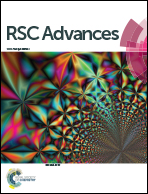Photo-crosslinked hierarchically honeycomb-patterned/macroporous scaffolds of calcium phosphate cement promote MC3T3-E1 cell functions†
Abstract
Advanced technology has enabled us to investigate cell functions in biomimetic honeycomb films or macroporous inorganic scaffolds to tentatively seek more powerful engineered biomaterials for bone regeneration. However, to date, the cell functions of honeycomb-patterned 3-dimensional scaffolds have not been studied. Herein, we report a facile and novel approach to fabricate photo-crosslinked hierarchically honeycomb-patterned/macroporous calcium phosphate cement (CH-CPC) scaffolds and their biological impact on MC3T3-E1 cells. The CH-CPC scaffolds together with controls, photo-crosslinked calcium phosphate cement scaffolds without honeycomb pores (CW-CPC) and calcium phosphate cement (CPC) scaffolds, were characterized by scanning electron microscopy (SEM), X-ray diffraction (XRD), energy dispersive spectroscopy (EDS), gel fraction measurement, thermogravimetric analysis (TGA), Brunauer–Emmett–Teller (BET) tests, and mechanical testing. The CH-CPC scaffolds were fully covered with a honeycomb layer with a pore diameter of 1.5–3.7 μm on the scaffold surface and the inside of the CH-CPC scaffolds was also covered with a honeycomb layer, but with poorer coverage and regularity in terms of pore size. The crosslinked networks in CW-CPC and CH-CPC scaffolds enhanced their compressive strength. The surface area and water adsorption in CH-CPC scaffolds were significantly higher than those of CPC and CW-CPC scaffolds due to the formation of honeycomb pores, which also promoted fibronectin (FN) adsorption on CH-CPC scaffolds. MC3T3-E1 cells were seeded on these scaffolds to study the cell response. The results clearly suggested that, in comparison with CPC and CW-CPC scaffolds, cell adhesion, spreading, proliferation, and differentiation were enhanced on CH-CPC scaffolds.


 Please wait while we load your content...
Please wait while we load your content...